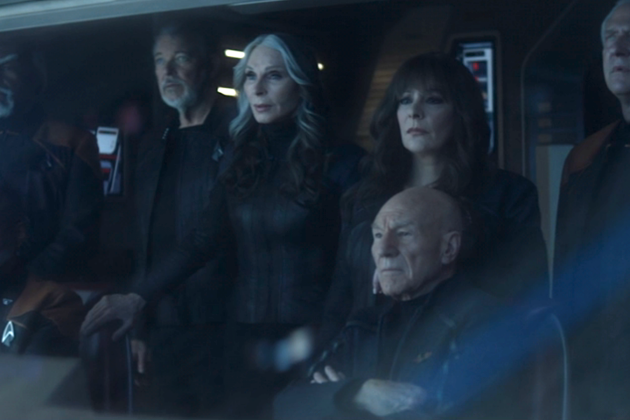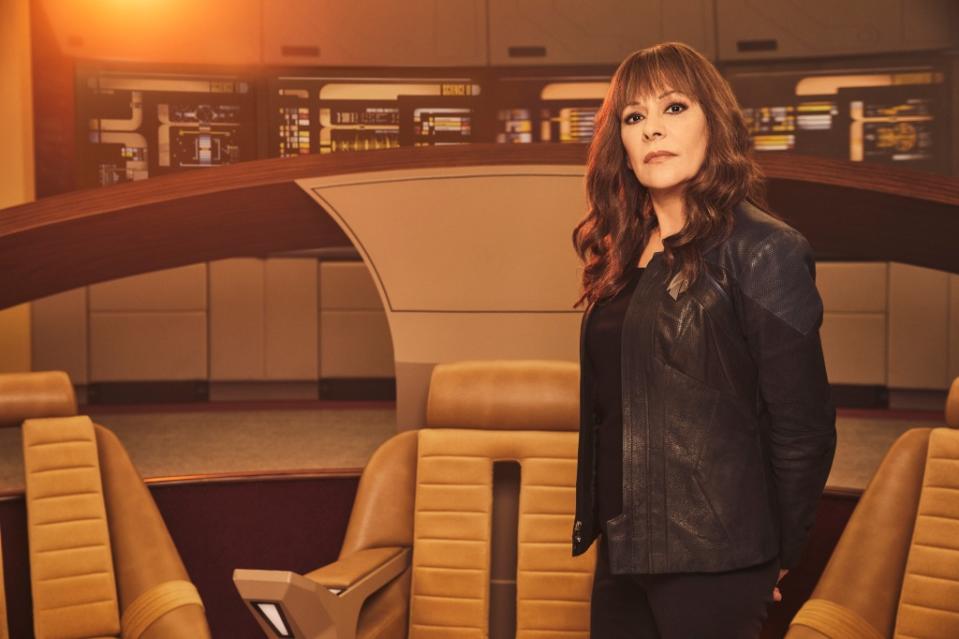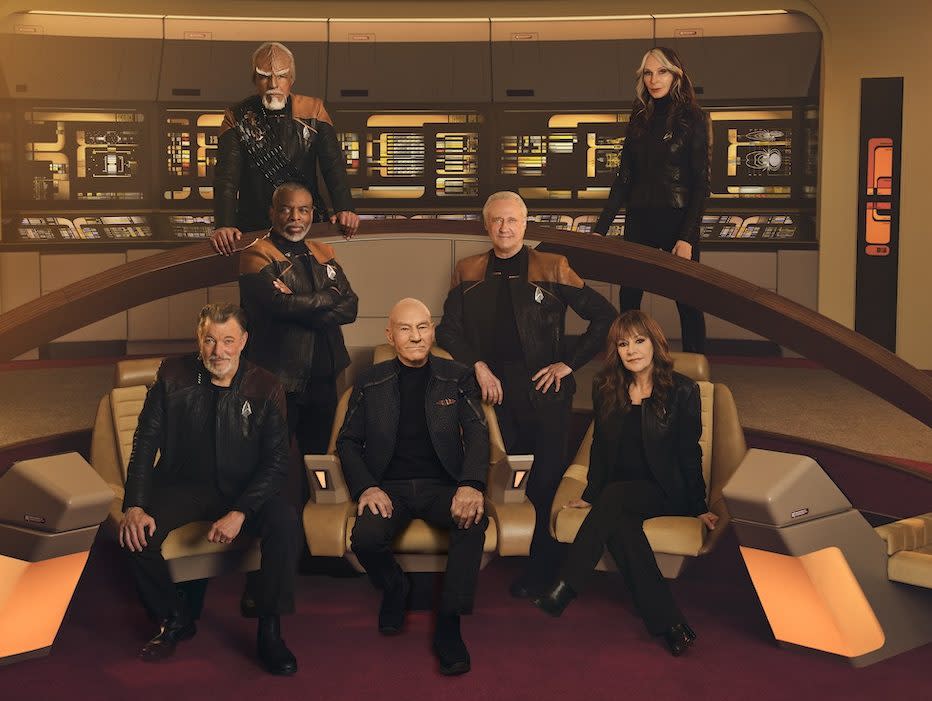How ‘Star Trek: Picard’ Resurrected an Iconic Set
- Oops!Something went wrong.Please try again later.
- Oops!Something went wrong.Please try again later.
- Oops!Something went wrong.Please try again later.
- Oops!Something went wrong.Please try again later.

SPOILER ALERT: This story discusses major plot developments in Season 3, Episode 9 of “Star Trek: Picard,” currently streaming on Paramount+.
All season long, the producers of “Star Trek: Picard” have boldly pulled out all the stops to make the third and final season one for the books. To that extent, it seemed like only a matter of time until we finally got to see the Enterprise — that is, the Enterprise-D, the Galaxy-class starship that made its first appearance in 1987 with the premiere episode of “Star Trek: The Next Generation.”
More from Variety
That moment of truth finally came at the end of “Vox” — the 9th and penultimate episode of Season 3 — when the reunited bridge crew took their stations on the Enterprise-D, which turns out to be the only Federation starship capable of resisting assimilation by the powerful Borg.
Executive producer Terry Matalas went through hoops to make sure history never forgot the name Enterprise. Speaking with Variety, and sharing photos of “The Next Generation” cast on the ship, Matalas says, “Everyone tried to talk us out of doing this, because financially it’s a nightmare, and the timing was tight. To the moment we started filming, we were still gluing pieces together. But you can’t have a ‘Star Trek: The Next Generation’ reunion without one of its major characters, which is the Enterprise.”

As for how it was even possible for the Enterprise-D to exist after it was virtually destroyed in 1994’s “Star Trek: Generations” (only the top saucer section was still intact after crash-landing on the planet Veridian III), it turns out Geordi La Forge took it upon himself to completely restore it for the Starfleet Museum.
However, despite the prominent presence of the Enterprise-D bridge on seven seasons of the TV series that ran from 1987 to 1994 (as well as the 1994 “Generations” feature film), construction guidelines were scarce for production designer Dave Blass and art director Liz Kloczkowski, who spearheaded the project.

“There’s the ongoing rumor that there’s a warehouse somewhere that has all this ‘Star Trek’ stuff, but what exists is not a lot,” Blass says. “We went into the deep dive of looking at every photo ever taken and every screencap, and we had a giant wall of inspiration at the back of the soundstage with photos of every single detail, so that everyone could see that we had thought this through.”
Blass pivoted to another invaluable resource when he recruited “Star Trek” legends Mike Okuda and Denise Okuda (from Herman Zimmerman’s “Next Generation” production design team) as consultants.
“The Enterprise from ‘The Next Generation’ was the first Enterprise on which I was the principal graphic designer,” Okuda says. “I got to work with [‘Star Trek’ creator] Gene Roddenberry on making that bridge come to life.”

But even with that deep-dive knowledge and experience, finding the source materials to reconstruct the bridge still proved to be a daunting challenge.
“The first thing we did was to go in the garage and dive into boxes and see what we still had,” Okuda says. “We had some original drawings and art, but large chunks of it disappeared. You realize you’re going to have to reconstruct a lot of this from scratch.”

It took three months and a team of around 50 people to completely rebuild the bridge, which was a physical build and not done on a green screen or in VFX. It measured exactly the same as the original set: 50 feet wide and 100 feet long.
All this work was in addition to every other set built for Seasons 2 and 3, which were shot back to back. “We were doing all the interiors of the starship Titan – like the bridge, the transporter rooms, the crew quarters, the hallways and sickbay – as well as [the enemy ship] the Shrike, Daystrom Station and the Borg,” says Blass. “So, all that all on top of each other.”

The goal was to re-create the look of the LCARS panels, as closely as possible to their appearance in “Star Trek: The Next Generation.”
“We took advantage of the huge advances in real-world computer display technology to make a few subtle upgrades to the displays,” Okuda says. “In a scene where one of our officers is using the science equipment, if the director wanted to show the scan itself, we would have had to insert the animation in post-production, back in the day. Now, it’s easy to do the animation and have it play back on the set, so the cast could see it in real-time.”

When it came to challenges, Blass says, the wood archway was one of the hardest pieces to recreate. “It’s a complex curve that arches and changes thickness,” he explains. “You can only get so much information off a blueprint. The construction team printed out a full-size paper plan to lay it out and then used a number of templates to shape the final piece.”
The chairs were another set piece in recreating the Enterprise-D that needed to be taken into consideration. “We had to sculpt the right shape based on the basic form, then do a deep dive on the right materials that have the right color and texture,” Blass says. “Each chair has four different materials.”

Blass adds that the infamous carpet, referenced by Patrick Stewart’s Jean-Luc Picard in the episode, “was very hard to find as it’s a pattern that has been out of stock for decades.”
It wasn’t just about the physical construction of the bridge, either; it was also about the lighting.
“That was tricky because you’re talking about lighting that was much more intrinsic to the 1990s,” Matalas says. “Now we have different cameras in a different cinematic style to the show. We had to find a hybrid of the old style and the new with our director of photography, John Joffin, and I think we found a really great sweet spot.”

When the cast saw the bridge for the first time, they got right down to business.
“This season was so ambitious, and we only had two days to shoot on this thing,” Matalas says. “It was literally, like, get everybody on, you got your four minutes of nostalgia, and then we have to boogie. But it was all very natural for them. It was like being back on Stage 8 at the Paramount lot. Patrick Stewart even did the ‘Picard maneuver,’ which he was very proud of.”
And what of the ship today?
Their work remains intact. “There were lots of interested parties who wanted to save the set,” Blass says. “Luckily it has a home in the Star Trek archives.”

Best of Variety
Sign up for Variety’s Newsletter. For the latest news, follow us on Facebook, Twitter, and Instagram.

